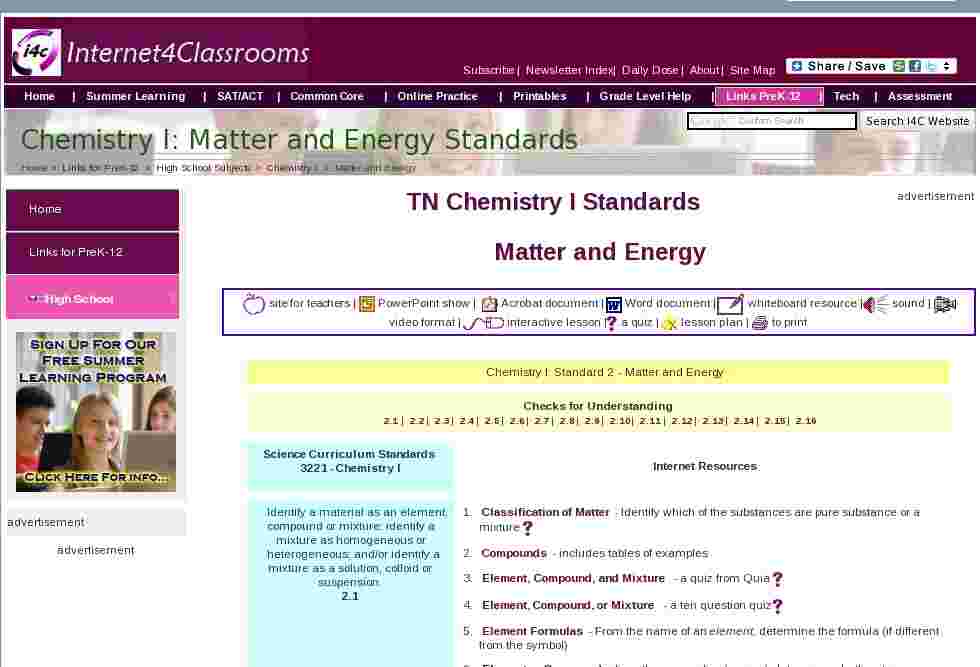Chemistry I: Standard 2 - Matter and Energy |
|
Science Curriculum Standards
3221 - Chemistry I
|
Internet Resources |
Identify a material as an element, compound or mixture; identify a mixture as homogeneous or heterogeneous; and/or identify a mixture as a solution, colloid or suspension.
2.1 |
- Classification of Matter - Identify which of the substances are pure substance or a mixture

- Compounds - includes tables of examples
- Element, Compound, and Mixture - a quiz from Quia

- Element, Compound, or Mixture - a ten question quiz

- Element Formulas - From the name of an element, determine the formula (if different from the symbol)
- Element or Compound - from the name of a chemical, determine whether it is an element or compound
 Element or Compound - a 58 slide PowerPoint show with good images, questions, and assignments Element or Compound - a 58 slide PowerPoint show with good images, questions, and assignments - Is a Diamond Element or Compound - answer to the question from Ask A Scientist
- Network or Molecular Compounds - from the name of a compound, determine whether it is network or molecular
|
Identify the solute and solvent composition of a solid, liquid or gaseous solution.
2.2 |
|
Express the concentration of a solution in units of ppm, ppb, molarity, molality, and percent composition.
2.3 |
|
Describe how to prepare solutions of given concentrations expressed in units of ppm, ppb, molarity, molality, and percent composition.
2.4 |
|
Investigate factors that affect the rate of solution.
2.5 |
- A Quick Look at How Ionic Compounds Dissolve - animation of salt dissolving in water

- Solution Graphic Organizer - click on blue words to see other related concept maps
- Solutions, Suspensions, Colloids, and Dispersions - definition and examples [from the About network]
- What's in a Solution? - definition, examples and activities
|
Describe how to prepare a specific dilution from a solution of known molarity.
2.6 |
|
Determine the colligative properties of a solution based on the molality and freezing point or boiling points of the solvent.
2.7 |
|
Use a solubility graph, composition of a solution and temperature to determine if a solution is saturated, unsaturated or supersaturated.
2.8 |
|
Classify properties and changes in matter as physical, chemical, or nuclear.
2.9 |
- What is the difference between chemical and physical change?
- Physical or Chemical Change? - Determine if each is a physical or chemical change. (a quia quiz)

- Physical or Chemical Change? - test your knowledge

- Physical vs Chemical Change - an interactive lesson

- Physical and Chemical changes quiz

|
Use calorimetry to: identify unknown substances through specific heat, determine the heat changes in physical and chemical changes, determine the mass of an object, and determine the change in temperature of a material.
2.10 |
|
Perform calculations on heat of solvation, heat of reaction, and heat of formation, and heat of phase change.
2.11 |
|
Use particle spacing diagrams to identify solids, liquids, or gases.
2.12 |
|
Distinguish among solid, liquid, and gaseous states of a substance in terms of the relative kinetic energy of its particles.
2.13 |
|
Use a phase diagram to correlate changes in temperature and energy with phases of matter.
2.14 |
|
Graph and interpret the results of experiments that explore relationships among pressure, temperature, and volume of gases.
2.15 |
|
Solve gas law problems.
2.16 |
|
|
Distinguish among elements, compounds, solutions, colloids, and suspensions.
SPI 2.1 |
|
Identify properties of a solution: solute and solvent in a solid, liquid or gaseous solution; procedure to make or determine the concentration of a solution in units of ppm, ppb, molarity, molality, percent composition, factors that affect the rate of solution, and colligative properties.
SPI 2.2 |
|
Classify a solution as saturated, unsaturated, or supersaturated based on its composition and temperature and a solubility graph.
SPI 2.3 |
|
Classify a property of change in matter as physical, chemical, or nuclear.
SPI 2.4 |
|
Compare and contrast heat and temperature changes in chemical and physical processes.
SPI 2.5 |
|
Investigate similarities and differences among solids, liquids and gases in terms of energy and particle spacing.
SPI 2.6 |
|
Predict how changes in volume, temperature, and pressure affect the behavior of a gas.
SPI 2.7 |
|
|
site for teachers |
PowerPoint show |
Acrobat document |
Word document |
whiteboard resource |
sound |
video format |
interactive lesson |
a quiz |
lesson plan |
to print

Element or Compound - a 58 slide PowerPoint show with good images, questions, and assignments


 Custom Search
Custom Search